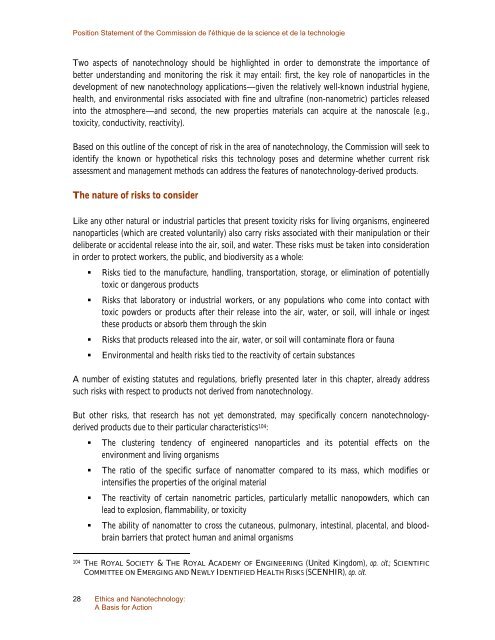A Basis for Action - Commission de l'éthique de la science et de la ...
A Basis for Action - Commission de l'éthique de la science et de la ...
A Basis for Action - Commission de l'éthique de la science et de la ...
You also want an ePaper? Increase the reach of your titles
YUMPU automatically turns print PDFs into web optimized ePapers that Google loves.
Position Statement of the <strong>Commission</strong> <strong>de</strong> l'éthique <strong>de</strong> <strong>la</strong> <strong>science</strong> <strong>et</strong> <strong>de</strong> <strong>la</strong> technologie<br />
Two aspects of nanotechnology should be highlighted in or<strong>de</strong>r to <strong>de</strong>monstrate the importance of<br />
b<strong>et</strong>ter un<strong>de</strong>rstanding and monitoring the risk it may entail: first, the key role of nanoparticles in the<br />
<strong>de</strong>velopment of new nanotechnology applications—given the re<strong>la</strong>tively well-known industrial hygiene,<br />
health, and environmental risks associated with fine and ultrafine (non-nanom<strong>et</strong>ric) particles released<br />
into the atmosphere—and second, the new properties materials can acquire at the nanoscale (e.g.,<br />
toxicity, conductivity, reactivity).<br />
Based on this outline of the concept of risk in the area of nanotechnology, the <strong>Commission</strong> will seek to<br />
i<strong>de</strong>ntify the known or hypoth<strong>et</strong>ical risks this technology poses and <strong>de</strong>termine wh<strong>et</strong>her current risk<br />
assessment and management m<strong>et</strong>hods can address the features of nanotechnology-<strong>de</strong>rived products.<br />
The nature of risks to consi<strong>de</strong>r<br />
Like any other natural or industrial particles that present toxicity risks <strong>for</strong> living organisms, engineered<br />
nanoparticles (which are created voluntarily) also carry risks associated with their manipu<strong>la</strong>tion or their<br />
<strong>de</strong>liberate or acci<strong>de</strong>ntal release into the air, soil, and water. These risks must be taken into consi<strong>de</strong>ration<br />
in or<strong>de</strong>r to protect workers, the public, and biodiversity as a whole:<br />
• Risks tied to the manufacture, handling, transportation, storage, or elimination of potentially<br />
toxic or dangerous products<br />
• Risks that <strong>la</strong>boratory or industrial workers, or any popu<strong>la</strong>tions who come into contact with<br />
toxic pow<strong>de</strong>rs or products after their release into the air, water, or soil, will inhale or ingest<br />
these products or absorb them through the skin<br />
• Risks that products released into the air, water, or soil will contaminate flora or fauna<br />
• Environmental and health risks tied to the reactivity of certain substances<br />
A number of existing statutes and regu<strong>la</strong>tions, briefly presented <strong>la</strong>ter in this chapter, already address<br />
such risks with respect to products not <strong>de</strong>rived from nanotechnology.<br />
But other risks, that research has not y<strong>et</strong> <strong>de</strong>monstrated, may specifically concern nanotechnology<strong>de</strong>rived<br />
products due to their particu<strong>la</strong>r characteristics 104 :<br />
• The clustering ten<strong>de</strong>ncy of engineered nanoparticles and its potential effects on the<br />
environment and living organisms<br />
• The ratio of the specific surface of nanomatter compared to its mass, which modifies or<br />
intensifies the properties of the original material<br />
• The reactivity of certain nanom<strong>et</strong>ric particles, particu<strong>la</strong>rly m<strong>et</strong>allic nanopow<strong>de</strong>rs, which can<br />
lead to explosion, f<strong>la</strong>mmability, or toxicity<br />
• The ability of nanomatter to cross the cutaneous, pulmonary, intestinal, p<strong>la</strong>cental, and bloodbrain<br />
barriers that protect human and animal organisms<br />
104 THE ROYAL SOCIETY & THE ROYAL ACADEMY OF ENGINEERING (United Kingdom), op. cit.; SCIENTIFIC<br />
COMMITTEE ON EMERGING AND NEWLY IDENTIFIED HEALTH RISKS (SCENHIR), op. cit.<br />
28 Ethics and Nanotechnology:<br />
A <strong>Basis</strong> <strong>for</strong> <strong>Action</strong>
















